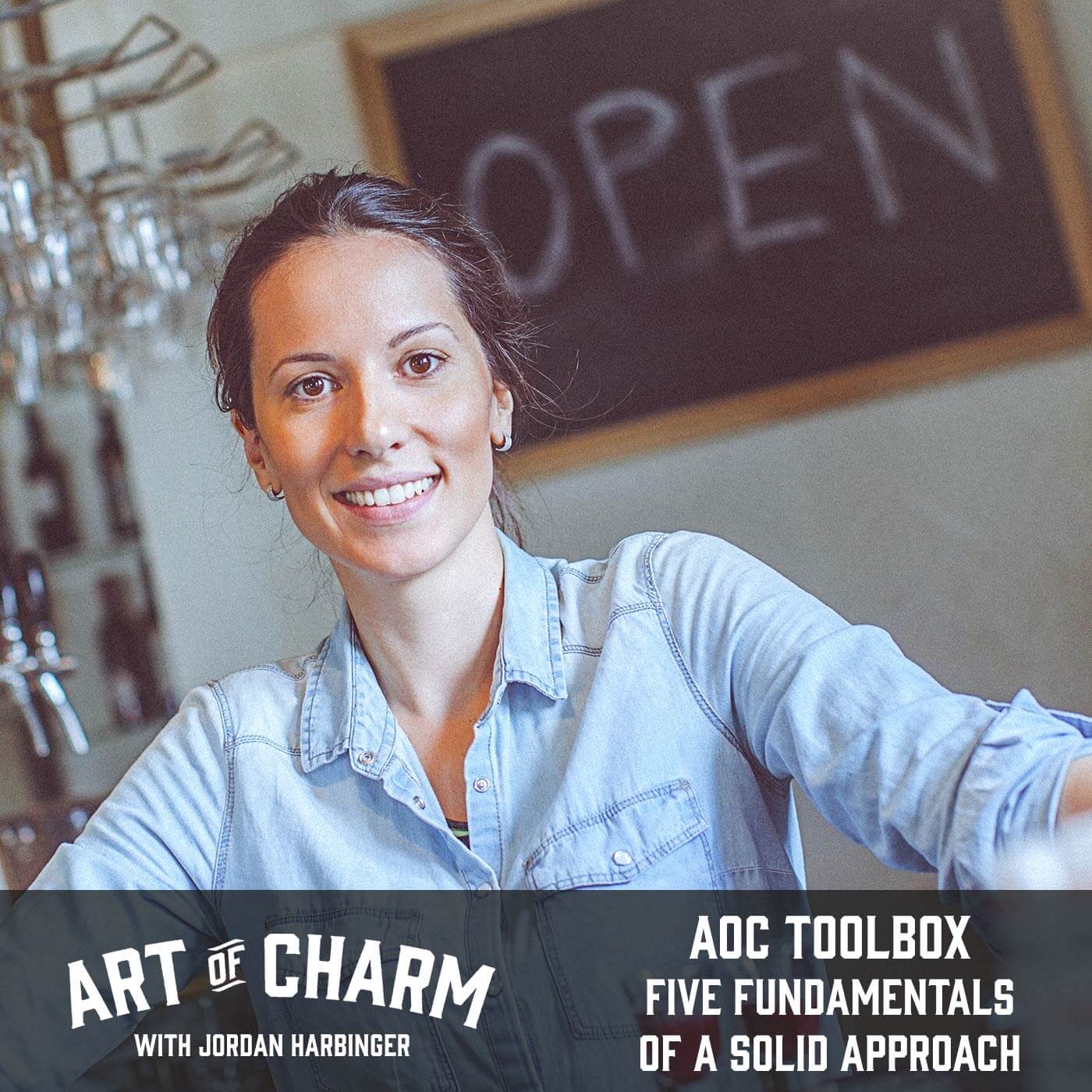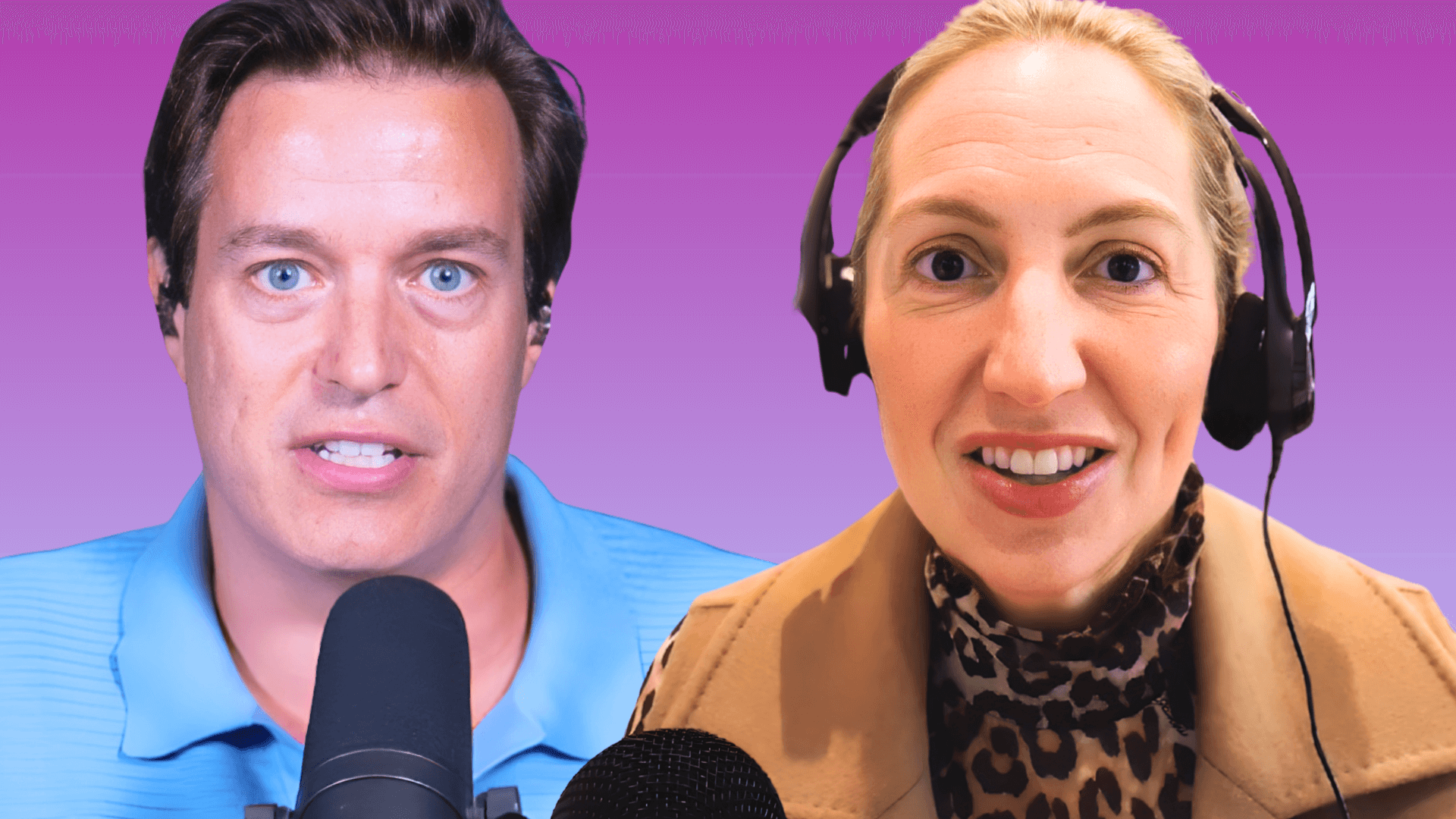The Art of Charm (@TheArtofCharm) trio of Johnny, AJ, and Jordan lay out the five fundamentals of a solid approach when you want to make an engaging connection with someone.
“Welcome to AoC Dojo!” -AJ Harbinger
The Cheat Sheet:
- If you want to engage in a meaningful connection with someone, remember these five fundamentals of a solid approach.
- Smile.
- Understand when and how to make and break eye contact.
- Show enthusiasm.
- Practice neutral body language.
- Demonstrate commitment.
- Listen to this Toolbox episode in its entirety for all of the details!
[aoc-subscribe]
For most of us, approaching a stranger can be a stressful endeavor on a good day. And if we really botch the job, we know full well it can lead to an extended period of awkwardness from which both parties strive to extricate themselves with great haste. This kind of an approach leaves us feeling like a clueless doofus for the rest of the day, with echoes of embarrassment haunting us each time its memory is recalled for years to follow. But it doesn’t have to be that way.
In this toolbox episode of The Art of Charm, Johnny and AJ discuss the five fundamentals of a solid approach that will allow you to fearlessly engage — and make a meaningful connection — with anyone. If you’re ready to ditch the fear of meeting new people and stop missing out on the chance to turn everyday strangers into lifelong friends, then listen, learn, and enjoy!
More About This Show
“Hope is not a strategy,” says AJ. “You’re hoping that people are going to approach you and that’s it? You’re going to be hurting when it comes to your social life, your business life, and your ability to attract interest in the opposite sex. So we definitely want to understand how to approach people with confidence so that we can have those amazing conversations.”
We’ve all been there. You’re at a party, or a club, or a business conference and in walks… the person who’s going to change your life. Or at least make the rest of the night a whole lot more interesting. It’s the man or woman you’ve been waiting your whole life to meet, or the executive who’s going to give you your next job, or invest in your million-dollar idea. All you’ve got to do is walk up, say the magic words, and bam — they’ll be eating out of your hands and feeding you grapes the next morning!
Easy peasy, right? For most people, of course, there’s nothing easy about it at all. In fact, when presented with these potentially life changing moments, many of us will often freeze up in fear. If we are able to get our legs churning, we may find them carrying us in the completely opposite direction.
But not to fear, The AoC is here. With our futures standing across the room, there’s only one thing we need to focus on for success: making a solid approach. So today we want to take a closer look at the five fundamentals of a solid approach. I’m talking about those non-verbal tools that will allow us to really engage the objects of our attention, with which we must equip ourselves as we prepare to meet our destiny.
The Five Fundamentals of a Solid Approach
1. Smile
Like an airplane deploying its landing gear, the wheels you want to put down first on your approach is your smile. Nothing fancy called for here, just a warm, genuine, full-faced smile that accomplishes several important goals almost immediately:
- It signals your own approachability.
- It lets your subject know you come in peace, and puts them at ease.
- It lets them know you’re having fun — that you’re ready to enjoy their company and, better yet, that they’ll enjoy yours.
The genuine part is important, because science also shows that people will trust you less if they think your smile is insincere. Again, you don’t have to stress on this one. Just relax into an easy smile and make sure you’re beaming it on your approach so the recipient of your smile knows it’s meant just for them. Whatever you do, don’t try too hard or you’ll wind up looking like the guy trying to “smize” with Tyra Banks.
2. Eye Contact
Fundamental number two of a solid approach is eye contact. This is especially important because eyes are not only the windows to the soul, but also among the most essential tools we possess for connecting and communicating with another person. Unfortunately, many of us tend to err on the side of the extreme where eye contact is concerned — either nervously looking away or, worse, staring too hard and intensely during a conversation. (This can have the distressing consequence of causing the stare-ee to worry for their own safety, or perhaps our sanity.)
As we peer more closely at the essentials of successful eye contact, we find the middle ground between these two extremes is easier to stake out than we may have realized:
- We always want to begin an exchange with eye contact. That’s because our eye gaze is one of the most effective means of communication.
- Once a connection is established, however, we actually want to break eye contact and turn our heads ever so slightly to the sides. Not only does this bring our ears closer to those with whom we’re speaking and lets them know we’re listening attentively, but it also allows us to think more about what they’re saying.
- When we break eye contact, it’s important to maintain the level of our gaze to signal our continued interest in the conversation.
An engaging conversation includes a nice easy rhythm of holding and breaking eye contact. The more we leer and linger, the less we’ll be able to speak. So make sure eye contact is a retractable part of your landing gear!
3. Enthusiasm/High Energy
The third fundamental of a solid approach is enthusiasm. This means we want to bring a sense of high energy to each encounter. It does not mean a lot of movement, however.
There are only two things to keep in mind when it comes to bringing high energy to your next encounter:
- Approaching with energy and enthusiasm tells someone right off the bat, before you’ve even said a word, that you like what you do.
- Enthusiasm is a powerful form of communication and also, just as important, an essential lever productive people use to get things done.
The way I like to encourage enthusiasm in AoC attendees is by suggesting they treat each encounter as if their best friend just walked through the door. If you can approach every person you meet (or even half of them to start) with the same level of energy you’d give to a friend you haven’t seen in a while, you’ll vastly improve your chances of making that encounter a happy, productive one.
4. Neutral Body Language
Body language is one of the most important fundamentals of a solid approach, partly because it’s the first thing people will notice about you from a distance. They won’t see your eyes — or know how good (or bad) you are at making eye contact — until you’re at close range. Body language is also one of our most powerful communication tools. Unfortunately, it’s a language most people often don’t know how to speak.
For anyone interested in the subject, I highly recommend a deeper dive. Learning how to speak clearly and effectively with your body is a skill you’ll be using for the rest of your life. Our goal today, however, is to highlight a couple of ways we can use body language to make a positive impact on a solid approach:
- After grabbing our subject’s attention with eye contact, we want to shift into neutral. This means standing side by side, keeping our feet even with them and pointing in the same direction. This type of posture increases their comfort level with us and eliminates the feeling of competition.
- Neutral body language is also a great way to reduce stress — in ourselves and those with whom we are trying to connect. A relaxed posture literally extends from head to toe, and signals to others that they are free to do the same.
Trust us. Mastering the art of neutral body language will pay big dividends over the years and decades to come. Your body’s engine will thank you, and so will the friends and colleagues who learn to follow your lead!
5. Commitment
The last fundamental of a solid approach is commitment. You know, that thing that so many of us spend our lives running from. Well, today we’re going to break commitment down into two digestible components and prove to you there’s really not so much to be afraid of after all.
- Commitment means first of all that you need to stand close enough to someone to signal close attention and focus, while still respecting their boundaries. A general rule of thumb is around three to ten feet for casual acquaintances and coworkers. But you want to close this gap to arm’s length as soon as appropriate; just make sure you wait for the right signals before you do, especially in the workplace.
- The second part of commitment rests in your ability to stay invested in the topic — and the companion — at hand.
Don’t worry if you get frazzled. We’ll cover practicing a graceful exit from conversations next time around. We realize that even just 90 seconds of real-time listening can feel like an eternity when we’re anxious or uncomfortable. But learning how to work through the initial discomfort of encounters will help build the kind of strong commitment muscles that’ll have you sticking your approaches every time!
THANKS, AoC!
If you enjoyed this session with The Art of Charm, let them know by clicking on the link below and sending them a quick shout out at Twitter:
Click here to thank AoC at Twitter!
Resources for Five Fundamentals of a Solid Approach
- Transcript for AoC Toolbox | Five Fundamentals of a Solid Approach (Episode 664)
- Worksheet for AoC Toolbox | Five Fundamentals of a Solid Approach (Episode 664)
- AoC Toolbox | Four Components of a First Impression (Episode 656)
Smile
- This showcases that you are approachable.
- Social Briefing #6: How to Make Yourself More Approachable by Brett and Kate McKay, The Art of Manliness
- Want to Make Friends? Eight Tips for Making Yourself Likable. by Gretchen Rubin
- These Facial Features Matter Most to First Impressions by Charles Q. Choi, Live Science
- It also lets them know you are having fun.
- The Truth Behind Why Smiles Sell And What This Means For Your Ads by Maria Van Leeuwaarde, New Neuromarketing
Eye Contact
- Make eye contact to start.
- Look ‘Em in the Eye: Part I – The Importance of Eye Contact by Brett and Kate McKay, The Art of Manliness
- Break eye contact when listening.
- Fascinating Facts About Eye Contact by Carol Kinsey Goman, Forbes
- Scientists Have a Theory on Why You Break Eye Contact by Elizabeth Armstrong Moore, Fox News Science
- Always break eye contact at eye level or higher.
- Eyes Body Language, Changing Works
- How Eye Contact Works, Psyblog
Enthusiasm/High Energy
- Treat them like you are meeting your best friend.
- The 5 Things You Learn within 3 Minutes of Meeting Someone New by Joel Comm, Inc.
- 4 Powerful Reasons to up Your Enthusiasm, and How to Do It by Henrik Edberg, The Positivity Blog
Neutral Body Language
- The Secrets of Body Language: Why You Should Never Cross Your Arms Again by Leo Widrich, Buffer Social
- Stand side-by-side instead of facing them.
- Why You Stand Side-by-Side or Face-to-Face by Audrey Nelson Ph.D., Psychology Today
- Pointing Your Body In the Right Direction from Body Language For Dummies by Elizabeth Kuhnke
- 8 Powerful Ways to Improve Your Body Language by Jeff Haden, Inc.
- This position allows tension to be released.
- How Body Language Can Lower Stress by Vanessa Van Edwards, Science of People
- Relaxed Body Language, Changing Works
Commitment
- Get inside someone’s personal space.
- How to Respect Other People’s Boundaries by Margarita Tartakovsky, M.S., PsychCentral
- Etiquette Rules of Defining Personal Space by Debby Mayne, The Spruce
- Be close enough to comfortably touch them to build rapport.
- Business Etiquette: Touching in the Workplace by Diane Gottsman, HuffPost
- Stay with an interaction.
- Do You Make These 10 Mistakes in a Conversation? by Henrik Edberg, The Positivity Blog
You’ll Also Like:
- The Art of Charm Challenge (click here or text AOC to 38470 in the US)
- The Art of Charm Bootcamps
- Elite Human Dynamics
- Best of The Art of Charm Podcast
- The Art of Charm Toolbox
- The Art of Charm Toolbox for Women
- Find out more about the team who makes The Art of Charm podcast here!
- Follow The Art of Charm on social media: Instagram | Twitter | Facebook
On your phone? Click here to write us a well-deserved iTunes review and help us outrank the riffraff!




